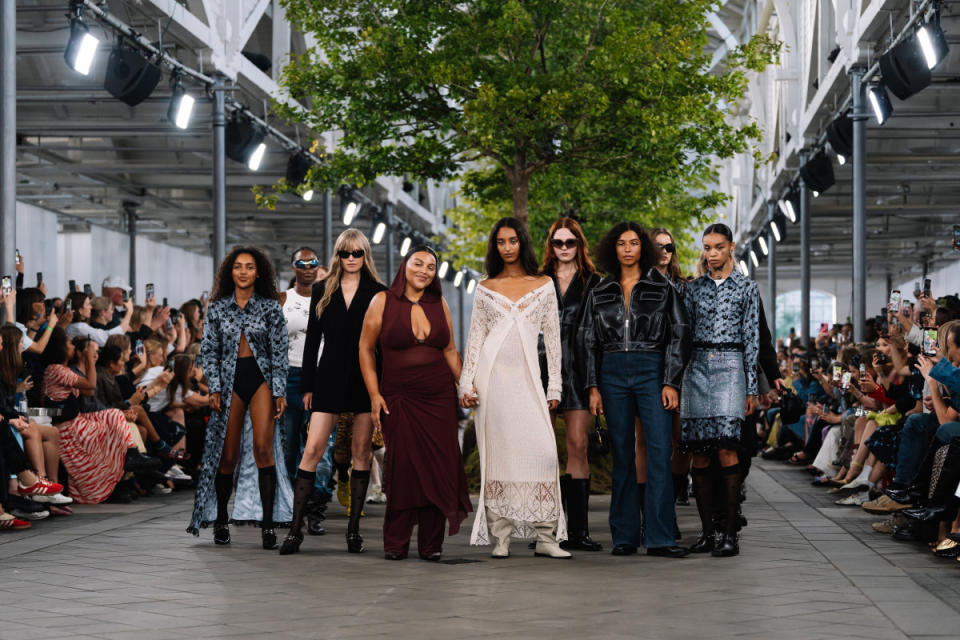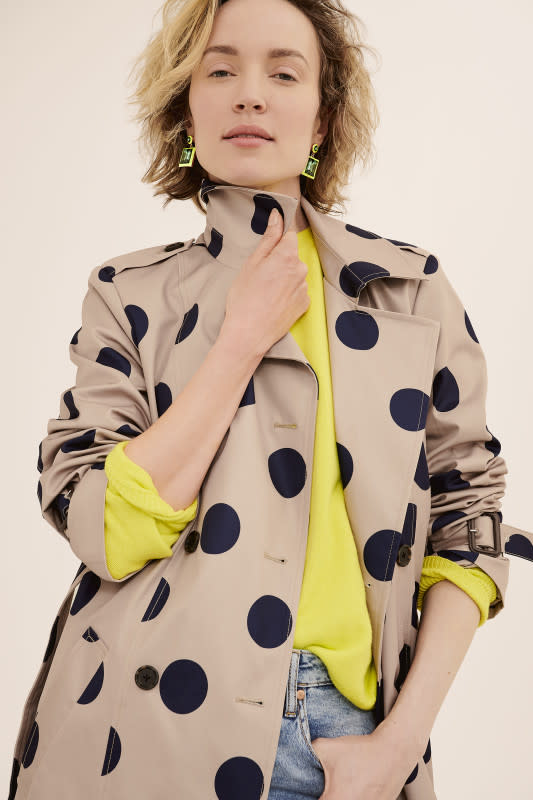Department Stores Are Rethinking Their In-House Contemporary Brands for a New Consumer
In fashion, the contemporary category is something of a relic. Despite its somewhat snoozy reputation, this segment of mid-priced designer brands known for having lower price tags than luxury labels was once ubiquitous, and for good reason: Besides being relatively approachable at the sub-$500 mark, contemporary has long served as a comfortable middle-ground for consumers looking for an important bridge — one between fashion victim and someone who might exist outside the trend cycle entirely.
There were the designer secondary lines like Marc by Marc Jacobs, DKNY and Kors by Michael Kors, plus the fleet of independent brands like Vince, Alice + Olivia and Theory. Department stores soared in this tier, with their own rosters of private labels helping to bring contemporary to a mass-market audience. By the mid-aughts, amid a booming fast-fashion landscape, fatigue set in, and, suddenly, contemporary was not so...well, contemporary anymore.
Until now, that is. At least, that's what a new wave of contemporary-priced brands is starting to indicate. Could this category — one that grew to feel stuffy, yet still omnipresent at retail — be transforming in real time?
This isn't the first time Fashionista has explored such a development. Five years ago, writer Hilary George-Parkin investigated this growing class of buzzy brands at accessible price points working to breathe new life into the contemporary market. Indeed, it was around this time that labels like Maggie Marilyn, Staud, Tibi, Rixo London and Nanushka exploded onto the scene, shaking up fashion week calendars and wholesale buys; LVMH-backed private equity firm L Catterton made its first investment in Danish "It" label Ganni just a year prior, in 2017, before putting it up for sale last summer.

Photo: Alena Zakirova/WireImage
The market has changed since then. According to Business of Fashion Retail Correspondent Cathaleen Chen, fashion's onslaught of never-ending price hikes, fueled by such factors as excess inventory and rising inflation, may have put the contemporary category over the edge. It's not just Chanel: Apparel prices as a whole rose 5.2% in June 2022 alone, on a year-over-year basis, as reported by the Bureau of Labor Statistics.
Contemporary has gotten "really, really, really expensive" amid changes in spending habits, Chen says. Her colleague Joan Kennedy has reported that amongst "aspirational" consumers (those in the $40,000-to-$100,000 earning bracket, according to Earnest Analytics, who typically shopped luxury brands at their entry price points), luxury spending is down 20% year-over-year so far in 2023. This coincides with what economists refer to as a "richcession" — a trending term coined in February by Wall Street Journal reporter Justin Lahart to describe a recession that disproportionately impacts rich people.
"Savings rates have gone down, so a lot of aspirational shoppers who were shopping up are no longer shopping up, and that has impacted how they spend, maybe influencing them to trade down," Chen argues.
Economic slumps aside, there's also post-pandemic priorities to consider, particularly as they relate to the sweeping return-to-office policies across workplaces and industries. Dress codes have changed after years spent in lockdown, and Jennifer Ortakales Dawkins, a senior retail reporter at Insider, speculates that this is generating demand for new types of professional wares.
"Contemporary has always been the go-to clothing for people looking for that mid-range, who want things to wear to work that they can also dress up," she explains. "People may not be going to the office full-time, but they still want really nice, professional-looking pieces that will serve them for everyday use throughout their life."
Retailers are betting big on this kind of lightning-in-a-bottle moment. In July, Macy's unveiled a new private womenswear brand, called "On 34th," that offers what the department-store chain refers to as "classics made for modern life." With over 750 SKUs and 250 unique styles, the collection is designed to be mixed and matched to create "over 1,000 outfits" — a portion of which are bound to be versatile enough to wear to your hybrid workplace and out to happy hour afterward. The price point is on the more attainable side of the contemporary category, ranging from $18.50 to $299.50; sizing goes from XXS to 4X and 0 to 26W.

Photo: Courtesy of On 34th
For Macy's, On 34th isn't a single attempt to capitalize on an economic trend, but rather part of a much broader strategy to reinvest in its in-house designs. At one time, its roster of 25 private brands reportedly drove close to 20% of Macy's sales. In recent seasons, though, that figure has dipped closer to 16%, which the retailer is angling to pick back up with the help of a stable of key hires, including Emily Erusha-Hilleque, a 22-year veteran of Target, as its SVP of private brands, as well as Bryan Riviere, most recently of Gap Inc., as SVP of private brand sourcing, product development and production.
In conversation with Fashionista, Erusha-Hilleque describes her Macy's kickoff to be what she calls a "listening and learning tour" with customers, which revealed a need for support in the contemporary space.
"The collection is rooted in wardrobe staples," she says. "We did a lot of research around, 'How would the customer speak to wardrobe staples?' Most people are looking for classic shapes and styles made for modern life. What are those items that resonate with most people in America, and how can we make something that is the best version of what those classic shapes are that have been around for a long time?"
Examples include $275 suede moto jackets, $49.50 straight-leg jeans, $99.50 roomy blazers. The brand also dips its toe into trendier offerings: At a recent tour of the collection at the Macy's flagship in New York City, Ortakales Dawkins was surprised to see a tutu-esque garment — the $79.50 Tulle Ruffle Midi Skirt — that's more of a timely play on "balletcore" than a wardrobe mainstay. This is all part of the strategy, though, with Macy’s having built out what Erusha-Hilleque refers to as a "very robust" internal trend research and forecasting team. Trust, she says: The tutu is there for a reason.
"Determining why certain things are trending at the moment and ensuring we have storytelling behind each piece is going to be really, really a powerful tool, and an asset to the company that we haven't had as robustly in the past," says Erusha-Hilleque.
View the original article to see embedded media.
The trend piece of the contemporary puzzle is just as relevant elsewhere, like Nordstrom, which launched its own answer to the fashion-conscious private label with 1.STATE in 2014. Initially debuting with a semi-corporate focus on tailoring, it has since evolved into a true mid-priced brand now sold in department stores throughout the U.S. such as Bloomingdale's and, yes, Macy's, as well as online retailers including Revolve.
Design veteran Carmen Rivera joined 1.STATE from Ulla Johnson in 2022, with the goal of revamping the label, establishing a brand identity that would set itself apart from others on the contemporary floor. The new-and-improved 1.STATE launched last month, with its first of three Fall 2023 deliveries coming in at a competitive price point: an average of $159 for outerwear, $119 for dresses and $79 for blouses.
While the trend cycle is part of the larger conversation, Rivera says, it's by no means her bread and butter. After all, the pieces she's designing today will be hitting the shop floor in a year, necessitating a certain level of discernment between long-term interests and micro-trends that "a lot of brands and companies survive on." The clothing is practical (and inherently workplace-appropriate), but also overtly feminine, with no shortage of flirty details like gauzy flutter sleeves and tie-neck details.
"Nothing can be too quick, but you can't be too late to a trend, either," she says. "It has to feel like it's the version that's the most palatable to the biggest audience, while still offering something that feels unique and specific."
Going forward, Rivera anticipates a steady surge in in-house contemporary labels, like On 34th or 1.STATE, if only because the margins are so much higher for retailers. But among consumers, there's also a growing appetite for newness by way of brands that can deliver smart, thoughtful garments at an attainable price. Retailers should be taking notes.
"There are plenty of shoppers who desire that kind of clothing, but I don't necessarily think that all consumers in that category know what's available to them," says Ortakales Dawkins. "It's also about creating the right pieces that will be high-quality and still a bit trendy, but also marketing them in a way where customers will actually notice."
Sign up for our daily newsletter and get the latest industry news in your inbox every day.


